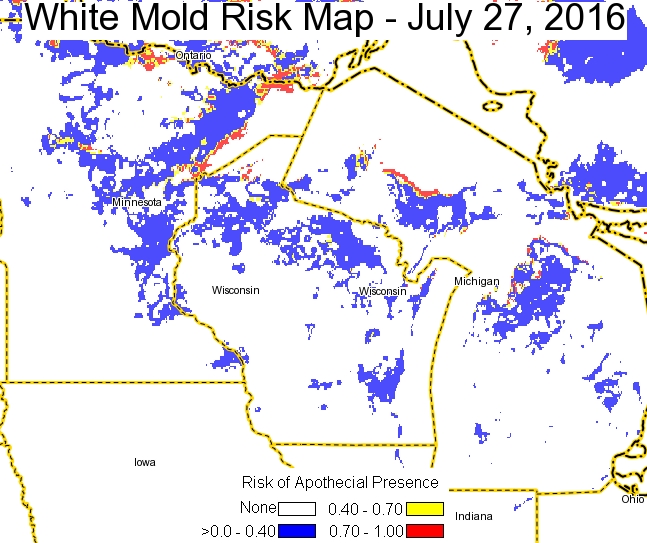Damon L. Smith, Extension Field Crops Pathologist, University of Wisconsin-Madison
Jaime Willbur, Graduate Research Assistant, University of Wisconsin-Madison
Sclero-cast: A Soybean White Mold Prediction Model
**This tool is for guidance only and should be used with other sources of information and professional advice when determining risk of white mold development. We encourage you to read the model how-to guide which can be downloaded by clicking here**
Risk of apothecial presence and subsequent white mold development risk has declined to the point that most of Wisconsin has no risk or low risk. Hot weather has continued to push the risk lower. The UW Field Crops Pathology crew has continued to scout production fields and has not found many fields with any apothecia. It is possible to find more apothecia in some irrigated fields. The window of opportunity to apply fungicides to control white mold in soybean is nearly over (Fungicides are not recommended after the R3 growth stage). Focus for our team will shift to looking for the disease next week in research plots and production fields.

White Mold Risk Map – July 27, 2016
This model was developed at the University of Wisconsin-Madison in conjunction with Michigan State University to identify at-risk regions which have been experiencing weather favorable for the development of white mold fungus apothecia. Weather information and maps are provided by the Soybean Integrated Pest Information Platform for Extension and Education (iPIPE), which is managed by ZedX, Inc. This model predicts when apothecia will be present in the field using 30-day averages of maximum temperature, maximum relative humidity, and maximum wind speed. Using virtually available weather data, predictions can be made in most soybean growing regions. Based on these predictions, this map is generated and indicates areas at no (white), low (blue), medium (yellow), and high (red) risk levels. Fields in yellow or red areas have >40% chance of having apothecia present and may be at risk of white mold developing later in the season. Model predictions must be combined with soybean growth stage and canopy characteristics to aid in timing of fungicide sprays. If the model is predicting medium to high risk in your area, soybeans are flowering, and the canopy is somewhat closed, then the white mold risk is elevated. For further information on how to use and interpret this risk map, CLICK HERE to download a how-to guide.



